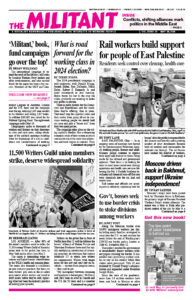After five days of trading missile fire, the Israeli government and Gaza-based Islamic Jihad agreed to a cease-fire May 13. The latest round of fighting — the 15th major clash between the Israeli army and Islamist militias in Gaza since 2008 — began May 9 after Islamic Jihad launched over 100 missiles at civilian populations in Israel May 2.
Islamic Jihad — which does the bidding of the reactionary regime in Iran — launched the rockets after Khader Adnan, one of its longtime spokesmen, died on the 86th day of a hunger strike in an Israeli prison.
By May 13, Israeli forces had killed six Islamic Jihad leaders and hit 420 targets in Gaza. Hamas officials said 33 people were killed. Over half were members of anti-Israel militias, some were civilians.
All but a handful of the more than 1,400 missiles and mortars Islamic Jihad launched were shot down by Israel’s anti-missile weapons, landed in unpopulated areas or fell short in Gaza. Two people were killed in Israel, one of them a Gaza resident working near the border.
Hamas — which rules Gaza and is the largest and best-armed Islamist group there — stayed out of the conflict. Despite sharing the aim of Islamic Jihad and Tehran to destroy Israel and drive all Jews “from the river to the sea,” Hamas depends on a modus vivendi with the Israeli government to stay in power and is reluctant to directly confront Israel militarily, despite previous clashes, at least for now.
Some 20,000 Gaza residents have permits to work inside Israel, a big source of income in a territory with an official unemployment rate over 45%. With the agreement of Israeli authorities, the Qatar government sends $8.2 million a month, mostly for Hamas’ administration.
A new escalation would not be popular among most working people in Gaza, who suffer the consequences of every war with Israel and who are chafing under the Hamas regime’s brutal stifling of any dissent.
The latest clash occurs amid shifts taking place in the relations and alliances among rival powers in the region and worldwide, exacerbated by Moscow’s invasion of Ukraine.
The counterrevolutionary bourgeois-clerical regime in Iran has stepped up its anti-Israel rhetoric in the wake of reestablishing diplomatic relations between Tehran and the government of Saudi Arabia in March. While that accord reflects a weakening of U.S. influence, the Saudi monarchy seeks to remain a U.S. ally while reviving relations with Tehran and seeking to return the Bashar al-Assad regime in Syria to Arab League membership.
The Saudi royal family also played a key behind-the-scene role in encouraging the governments of the United Arab Emirates, Bahrain, Kosovo, Morocco and Sudan to establish diplomatic and trade relations with Tel Aviv in 2020.
The 22-member Arab League readmitted the Syrian regime this month. It was expelled in November 2011 after launching a bloody massacre against protests by working people demanding democratic rights and the fall of the regime.
Despite funding and arms from the governments of Saudi Arabia, Turkey and others, rival bourgeois opposition forces and Islamist militias were unable to topple Assad, who survived due to aid and military intervention from Moscow and Tehran. The Turkish government took advantage of the civil war to occupy part of Syrian territory and attack Kurdish groups on its border it sees as a threat. The Kurds used the war to establish autonomy in northern Syria and allied with Washington to defeat Islamic State.
3.6 million Syrian refugees in Turkey
More than 300,000 civilians were killed during the war in Syria and 14 million Syrians — out of a prewar population of 23 million — fled their homes. While 6.8 million are “displaced” inside Syria, others left the country, including more than 3.6 million now in Turkey.
Both Turkish President Recep Tayyip Erdogan and his opponent, Kermal Kilicdaroglu, caught up in a hotly contested presidential election, say they want to send the refugees back. It’s no secret that Washington favors Kilicdaroglu, hoping an opposition victory would spark a shift from Erdogan’s growing relations with Moscow.
Assad has conditions for accepting the refugees’ return — Turkish troops out of northern Syria. The foreign ministers of Turkey, Russia, Iran and Syria met in Moscow May 12 to try to reach some agreement.
While Beijing helped “broker” the Saudi-Iran deal — looking for purchase in the area — and Moscow is trying to do the same in easing tensions between the Syrian and Turkish regimes, neither one has the military or economic clout to take the place of U.S. imperialism, still the predominant foreign power in the region. While Washington’s weakened role has increased the jockeying among rival powers, the new diplomatic agreements between the regimes in Iran, Turkey, Beijing, Moscow and Saudi Arabia doesn’t mean they have broader common interests.
Rivals compete in Lebanon
That’s certainly true in Lebanon, where the government reels from crisis to crisis, and the country has been without a president since October.
Tehran wants the next president to be someone allied with its close ally, the Shiite-based Hezbollah, the most powerful armed group in the country. Both the Saudi and U.S. governments object to this.
Meanwhile, the deep crisis facing working people there continues. In the year leading up to June 2022 food prices soared 332%. And there remain an estimated 1.4 million Syrian refugees in Lebanon.

